If you were to approach Cedar Point’s beachfront in 1990, you’d likely notice something very different about the wide midway that once housed Avalanche Run. It appears that the wild bobsled family coaster has disappeared just five years after its introduction, replaced by a large industrial warehouse. Make no mistake: this big, boxy, tan showbuilding does house a roller coaster, though unless you’re really paying attention, you’d probably not notice that it’s merely Avalanche Run in disguise.
Dispatch Master Transport
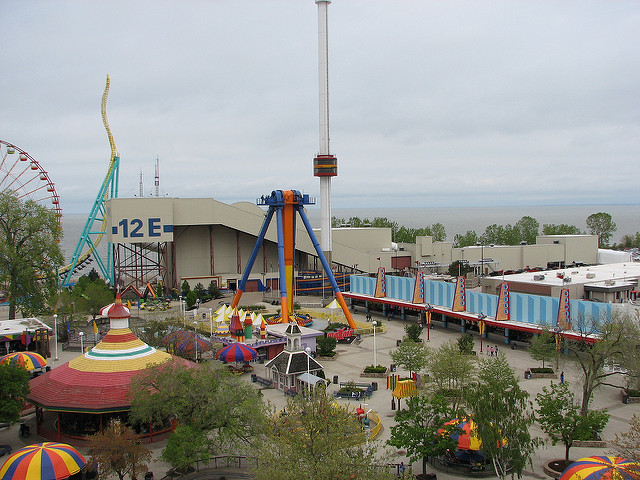
Entering the warehouse, you’d find yourself in a most unusual room, lit entirely by blacklight. The trippy room is filled with glowing travel posters, advertising exotic destinations around the world like Paris and Rome. This is the Mission Control room of Dispatch Master Transport – an interstellar delivery company of tomorrow.
And indeed, during Disaster Transport’s first years, this is where guests would meet “DAVE,” an Android not so unlike Rex himself, setting up the story.
According to DAVE, we’re new recruits joining Dispatch Master Transport. It might be that we’re hitching a ride aboard a space freighter for a no-frills journey, merely agreeing to deliver some packages along the way. In any case, Dave sets out our first mission: to deliver a shipment of cargo from a suborbital factory (our current location) to a remote station in Alaksa.
From here, we pass through Rocket Recovery – a hallway with windows looking into dayglo painted panel cutouts showing stocked warehouse rows of wooden crates. Then, into a corrugated steel tunnel painted black with phosphorescent, glowing handprints all around. With a pair of ChromaDepth glasses, the blue handprints would appear to recede away with the red handprints appearing to float in the foreground. The trippy, classic dark ride effect might’ve been dated by the ride’s 1990 debut, but it had a certain retro-cool.
And the blacklight motif continutes into the main queue room: the Repair Bay.
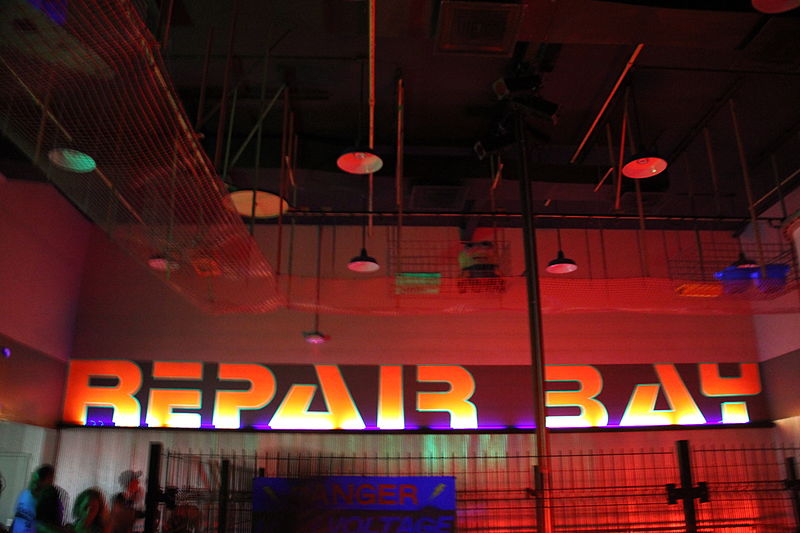
This Repair Bay centered around an oscillating tube of light, its undulating sound signaling its powering up over and over, with generators and science center style plasma globes meant to invoke a futuristic feel. Above, a continuous chain of caged rocket parts is moved along a conveyer belt, disappearing into distant rooms.
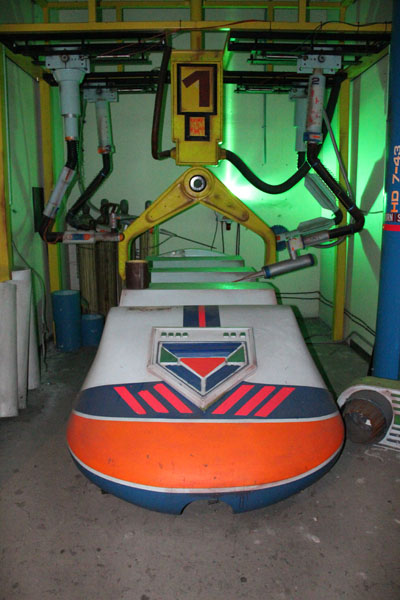
Indeed, this large queue room had some odd features, like blacklight “security cameras” and an unusual (and unintentionally humorous) sign that would like up with the word “REJECT” randomly as guests passed underneath, as if they’d been scanned. Garage doors along the room’s edge were mostly closed except Dock 1, wherein one of the ride’s sleds was being “repaired” by pneumatic articulating arms seeming to solder the train through flashing lights.
Rounding the corner, guests would pass by the apparant logo of this interstellar travel agency: Dispatch Master Transport. Get it? In any case, it was just a quick climb up a set of stairs and to the ride’s blacklight loading dock Launch Area, where a glowing team member would usher you onto a rocket waiting just for you.
LAUNCH
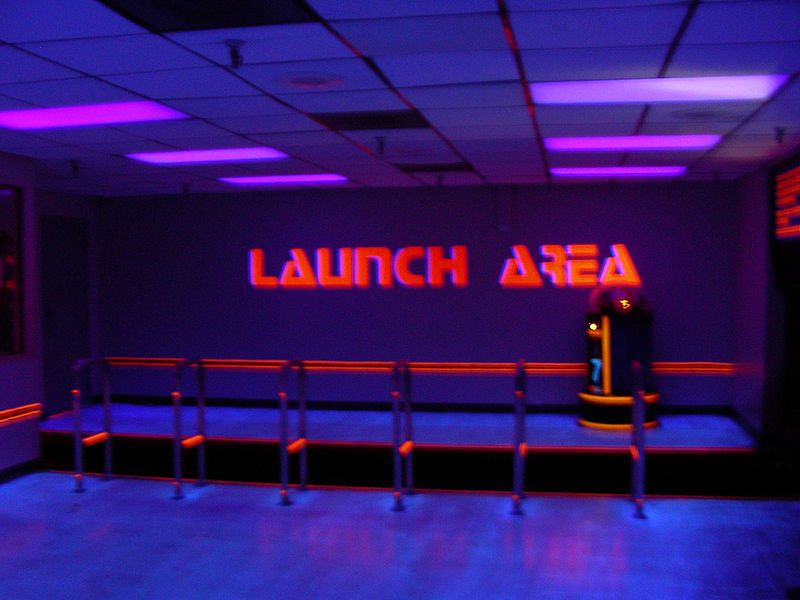
Your vessel to the stars is a repurposed bobsled from the former Avalanche Run, identical to the one you watched in the Repair Bay. Maybe this is the rocket from the Repair Bay. It’s seen better days. But maybe that’s the point.
You might notice that, unlike most roller coaster trains, this isn’t a “train” so much as it’s a “car.” There’s no articulating joints between seats. The solid rocket features five rows, each holding two guests. With only 10 guests per train, Disaster Transport has a relatively low hourly capacity. While it might be enough for a family ride like Avalanche Run, people seem inexplicably drawn toward “mysterious” rides that they can’t see, and that leaves Disaster Transport’s queue filled.
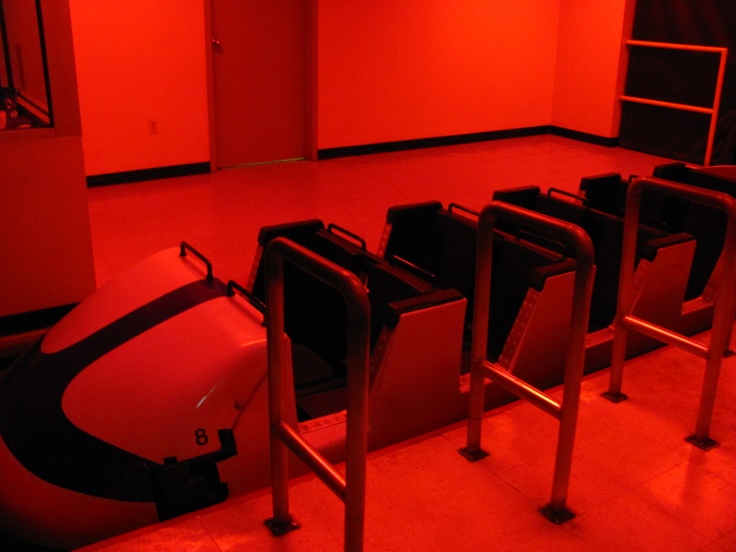
In any case, once on board the train slowly departs from the station and enters what very well may be one of the most grating lift hills on record. For more than a minute, the rocket clanks up the hill that feels more or less horizontal. In an unintentionally hilarious twist, the red and blue chaser lights lining the walls of the seemingly endless lift hill flash advancing up the hill and not down, thereby making your ascent seem even less significant. If this hill is meant to capture the same feeling of ascent as Disneyland’s Space Mountain, it woefully misses the mark. If it’s supposed to capture the retro awe of Magic Kingdom’s, it’s way off base.
In any case, the echoing click of the ride’s anti-rollbacks underscores the unbelievable lift hill. (Seriously… in the video below, we’ll challenge you to watch the whole thing without skipping ahead.)
Even if the lift hill doesn’t get across the idea of a launch, in the ride’s earliest days the lift hill would terminate in an endless star field projected inside the showbuilding overhead. (While this effect lasted longer than the rest, it was long gone by time the ride’s closure was announced.) With this brief, fleeting glimpse of stars projected ahead, the train would crest the lift hill and begin its descent. Finally entering into the bobsled tube, the coaster would zig and zag before passing through a large helix.
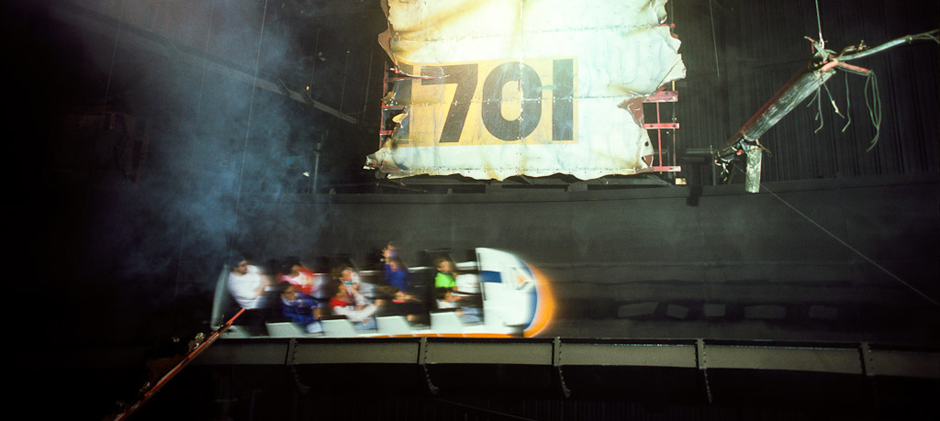
In the darkness, the wreckage of a space ship could be seen floating dead ahead, and as the coaster passes over a block brake, it dives to the left under the debris, entering the ride’s main showbuilding. Suddenly, glowing planets come into view and, in the center of the room, a large spaceship hovers like something from a Buck Rogers comic, glowing from the light of the planets and fiber optics sparks. The train spiral upwards around the perimeter of the room, viewing the spaceship from all sides.
Then, it re-enters the dark tubes that connect the ride’s showbuildings and twists away, with fiber optic stars overhead and quick flashes of strobes as the only chance to clearly make out the bobsled configuration that was once the ride’s hallmark.
After twisting left and right, the coaster would zoom into a final show scene – a small set of a Martian landscape compete with moon craters, jagged rocks, and a glowing, otherworldly sunset projected on a rear set. One final turn would bring the train to its final brake run, glowing under intense UV light with phosphorescent scientific keypads all around.
Deterioraring
At first, you might be bamboozled that the experience is already over. By any count, the lift hill took quantifiably longer than the ride itself. Still, your rocket arrives at the unload station and you disembark. After exiting down a set of steps, you find yourself back outside the showbuilding where a peculiar sign closes the loose narrative of the jumbled ride:

“Welcome to Alaska.”
You might have to re-read it to be sure, but yes. You’re now in Alaska. Indeed, in one of the final touches of storytelling the ride offers, you’ll notice that the flowerbeds are filled with white stones standing-in for snow.
At the height of the ride’s theming, a much clearer narrative via Dave (both in the queue and the lift hill) included starfields, projected explosions, and laser-blasting alien shuttles to cut your voyage short and turn your leisurely ride into a rescue mission. (And we wonder – was that last scene on the ride with Martian rocks meant to be our touchdown in Alaska?)
Original advertisements from the ride’s opening year may give an inkling at what the ride was supposed to offer (see right), which reads, “Blast-off into the future with an exciting voyage into the unknown […] The darkness of space will swallow you as your ship launches into a futuristic adventure where surprises lurk every moment. Surprises like alien satellites waiting to smash your spaceship with a blast of their powerful lasers, viscious space pirates planning an attack to steal your cargo, [and] enormous asteroids on a collision course threatening to pulverize your ship.”
By the 21st century, any indication of a plot was gone, as were the special effects, projections, starfields, lasers, audio cues, and more. To ride Disaster Transport after the new millennium would leave you stunned… and in this case, that’s not a compliment. Space pirates? Laser blasting aliens? Asteroids? If they were there, we must’ve blinked and missed them.
No matter. If anything, you might’ve thought Disaster Transport was humorous, with self-serious presentation and its dated effects (obviously half-flickered-out) as a light-hearted throwback to the 1970s (nevermind that the ride opened in 1990)! What wasn’t so funny was that some guests queued for an hour or more for the 50 second descent…
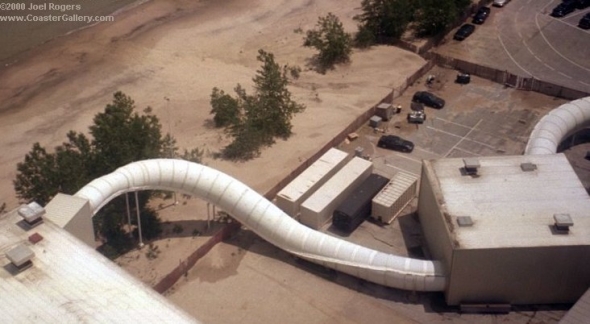
To be clear, Disaster Transport lived up to its name – it was a disaster. What remained of the ride’s “theming” by the 21st century was laughable, and there appeared to be absolutely no attempt to do so much as replace a lightbulb. As cobwebs gathered and the ride’s pre-show, music, lighting, and props disappeared one-by-one, Cedar Point inherited a laughing-stock ride that categorically failed at everything it had set out to do.
It would be one thing if Disaster Transport were a one-off miss. Instead, the ride’s outright failure signaled a changed in Cedar Fair that would last for decades. Wait until you see the domino effect set off by Disaster Transport… Read on…




As a child, my parents took me and my sister to Cedar Point in the late 50’s. There wasn’t much to the place then, the “standout” being the creaky old wax museum’s chamber of horrors, with its unbelievably horrific depictions of gruesome crimes (the worst one showed a woman tossing her babies into a burning oven—YIKES!!!). Shortly after the park began rebranding itself in the 60’s, notably with construction of the Blue Streak coaster, I began to visit at least once per year. I do remember the hype surrounding the new Avalanche Run coaster. I found it entertaining but less than stellar. When they reworked it into Disaster Transport, I gave it another chance. I found the lead up to the ride more interesting than the ride itself. I guess I’d hoped that they would have somehow made it more thrilling, but no, it was still the same sleepy Avalanche Run with the lights turned out. The special effects were cheesy at best, and on subsequent visits to the park, I found myself avoiding that ride more and more. I was not sorry to find that it was torn down.
I love the regional park forays into theming. Even when they fall flat on their face, it’s still entertaining (or at least fascinating).